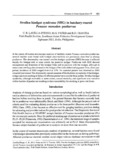Genetic diversity of wild and cultured black tiger shrimp (Penaeus monodon) in the Philippines using microsatellites
| dc.contributor.author | Xu, Zhenkang | |
| dc.contributor.author | Primavera, Jurgenne | |
| dc.contributor.author | de la Peña, Leobert D. | |
| dc.contributor.author | Pettit, Priscilla | |
| dc.contributor.author | Belak, Jane | |
| dc.contributor.author | Alcivar-Warren, Acacia | |
| dc.date.accessioned | 2014-01-16T11:14:48Z | |
| dc.date.available | 2014-01-16T11:14:48Z | |
| dc.date.issued | 2001 | |
| dc.identifier.citation | Xu, Z., Primavera, J. H., de la Pena, L. D., Pettit, P., Belak, J., & Alcivar-Warren, A. (2001). Genetic diversity of wild and cultured Black Tiger Shrimp (Penaeus monodon) in the Philippines using microsatellites. Aquaculture, 199(1-2), 13-40. | en |
| dc.identifier.issn | 0044-8486 | |
| dc.identifier.uri | http://hdl.handle.net/10862/1917 | |
| dc.description.abstract | Six microsatellites were used to study (1) the genetic diversity of wild Penaeus monodon shrimp from four geographic regions (Palawan, Quezon, Capiz and Negros Occidental-W) in the Philippines, and (2) its association with the status of mangroves and intensity of shrimp culture systems in these regions. Two cultured populations (Negros Occidental-C and Antique) were used for comparison. All six microsatellite loci were polymorphic. A total of 184 different alleles were found over all loci. The total number of alleles per locus ranged from 6 to 54, with allele size ranging from 159 base pairs (bp) to 400 bp. The observed heterozygosity of the six loci ranged from 0.47 to 1.00. The number of genotypes per locus ranged from 5 to 70. Fst values showed significant genetic differentiation among the four wild populations. Genetic differences between wild populations were also detected by pairwise comparison based on genotypic and allelic frequencies. Genetic differentiation among wild populations exhibited a positive correlation with mangrove status and intensity of culture systems at P=0.083. The Negros Occidental-W population, which originated from an area with the most severe mangrove loss and the most intensive culture systems, was the most significantly differentiated population. It also showed less genotypes per locus than the other three wild populations, suggesting a decrease in genetic diversity in this population. The population from Capiz, a province with a wide area of extensive culture ponds and few remaining secondary mangroves was the second most differentiated population. The Quezon population, which originated from an area with a few extensive culture ponds and less mangrove destruction, was not genetically different from the Palawan population, which was from a pristine site with mostly primary mangroves and no major aquaculture industry. The cultured populations showed less genetic diversity and were significantly different from the four wild populations based on pairwise Fst values and pairwise comparisons of allelic and genotypic frequencies. The results suggest that (a) there was a significant genetic differentiation among the wild P. monodon populations in the Philippines, and (b) the cultured populations were significantly differentiated from the natural populations. More replicate samples from each of the geographic regions are needed to conclusively determine the possibility of an association between genetic differentiation and the status of mangroves and/or intensity of shrimp culture systems. | en |
| dc.description.sponsorship | This research was funded by a grant from the Rockefeller Brothers Fund, Inc., New York, NY (to A.A-W). Partial funds were also obtained from the Curriculum Program and the Department of Environmental and Population Health at Tufts University School of Veterinary Medicine (TUSVM) (to A.A-W) and the Aquaculture Department of the Southeast Asian Fisheries Development Center, Philippines (SEAFDEC AQD) (to J.H.P. and L.P.). | en |
| dc.language.iso | en | en |
| dc.publisher | Elsevier | en |
| dc.subject | gene frequency | en |
| dc.subject | Penaeus monodon | en |
| dc.subject | Philippines | en |
| dc.subject | shrimp culture | en |
| dc.title | Genetic diversity of wild and cultured black tiger shrimp (Penaeus monodon) in the Philippines using microsatellites | en |
| dc.type | Article | en |
| dc.identifier.doi | 10.1016/S0044-8486(00)00535-4 | |
| dc.citation.volume | 199 | |
| dc.citation.issue | 1-2 | |
| dc.citation.spage | 13 | |
| dc.citation.epage | 40 | |
| dc.citation.journalTitle | Aquaculture | en |
| seafdecaqd.library.callnumber | VF SJ 0664 | |
| seafdecaqd.databank.controlnumber | 2001-11 | |
| dc.subject.asfa | culture effects | en |
| dc.subject.asfa | cultured organisms | en |
| dc.subject.asfa | microsatellites | en |
| dc.subject.asfa | genetic variation | en |
| dc.subject.asfa | geographical distribution | en |
| dc.subject.asfa | mangroves | en |
| dc.subject.asfa | mangrove swamps | en |
| dc.subject.asfa | population | en |
| dc.subject.asfa | population genetics | en |
| dc.subject.asfa | shrimp culture | en |
| dc.subject.scientificName | Penaeus monodon | en |
Files in this item
| Files | Size | Format | View |
|---|---|---|---|
|
There are no files associated with this item. |
|||
This item appears in the following Collection(s)
-
Journal Articles [1247]
These papers were contributed by Department staff to various national and international journals.




